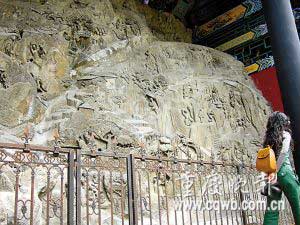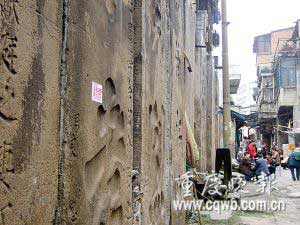

The Third National Relics Census is now being carried out. Census staff in Chongqing have found out that some cultural heritage artifacts have been damaged, some even disappearing.
Damage to ancient steles
Seven ancient steles in the Yuzhong District are often covered by illegal ads, which severely damage the cultural value of the steles. What is worse, the sanitary workers, with good intentions, coat the ads with lime water, causing even greater damage to the steles.
With a history of hundreds of years, these steles have important cultural and calligraphic value.
"Sometimes, only one or two days after we spread the lime water, new ads appear. We have to spread the lime water again and again," said a sanitary worker. When asked whether the lime water would destroy the stele, he said he had no idea.
A Ming Dynasty rock carving badly damaged
Hoping to attain good luck, many people climb onto a Buddha figure rubbing their notes with the "The Money Tree" in Laojun Cave Rock Carving in Nan'an District, Chongqing. This behavior brings damage to the rock carving. Relevant departments have installed an iron fence around the carving in order to prevent tourists from touching the Buddha. However, there are still some tourists who cross the fence wishing to "make a fortune."
The Laojun Cave Rock Carving is composed of many Taoist stories. Each story has its own figure and scenery. It was built in Ming Dynasty and is very susceptible to wind and water erosion. It can be easily destroyed if affected by natural forces.
Many cultural heritages are under a similar predicament. The Wenfeng Tower in the Nan'an District was carved with hundreds of sentences like "XX travels here," "XX, I love you" by tourists.
Ancient buildings inlayed with ceramic tiles
Xituo ancient town in Shizhu County will start its 30-million-yuan restoration plan from June this year.
Xituo ancient town has a batch of residential buildings dating back to Ming, Qing Dynasty and the early period of the Republic of China. Due to the lack of necessary protection and repairing, some of these buildings even collapse. On the contrary, ceramic tiles and glasses which are often used in modern architecture are inlayed on the ancient buildings. Nearly half of the ancient buildings are damaged due to natural forces or people.
Some of the residents said that they did not realize that ceramic tiles damage the cultural heritage. They just hoped that their houses could be as bright and modern as the others.
Cultural heritage destroyed during urban construction
Last July 4, the Chongqing Municipal Administration of Cultural Heritage was informed that a family tomb and some cultural heritages were found in a construction site in Jianqiao Industrial Park in Dadukou District. Cultural heritage protection staff rushed to the site to find that the ceiling of a tomb had been destroyed by the construction.
On July 20, the tomb was reexamined and was presumed to be a relic of Ming Dynasty.
Half a month later, when the staff went to examine for the third time, they found that the tomb was completely destroyed without a trace.
According to the Law on the Protection of Cultural Relics, construction organizations need to report to cultural heritage protection departments. Construction should be immediately paused if cultural relics are found and can be resumed after the relics are protected by the cultural heritage departments.
In fact, some construction organizations simply ignore the law, quitting their operation only after the public reports their behavior to the government.
Three steam trains sold as iron scrap
Last May 30, three steam trains from Songzao Coal and Electric Power Company in Chongqing retired and were sold as iron scrap. This makes the cultural relics protection experts sigh.
The steam train is the symbol of the Industrial Revolution. In recent years, more than 200 photographers came to Songzao, and called it the "Holy Land of the Steam Train Photographers," the "Last Paradise of Steam Trains," and many TV serials were shot here.
Like the three steam trains, many industrial relics in Chongqing are dying out. Experts think that Chongqing is an old industrial base and that industrial relics are a unique resource. However, there are no laws or regulations protecting the industrial relics. The Law on the Protection of Cultural Relics cannot be applied to protect the industrial relics. Besides, there is no verdict about whether the industrial relics are cultural relics. Luckily, Chongqing has stepped up efforts to protect remnants of Chongqing's industrial past.
(China.org.cn by Li Xiaohua, May 6, 2008)